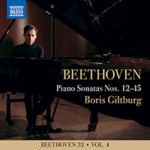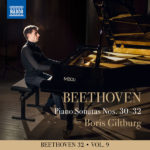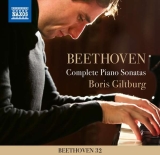Naxos veröffentlicht die Box mit allen vorher bereits einzeln erhältlichen CDs von Boris Giltburgs Beethoven32-Projekt, der Gesamtaufnahme aller Sonaten.
Der Zyklus ist sicherlich keiner, den man homogen nennen könnte. Giltburg interpretiert sehr individuell, gibt jeder Sonate ihren eigenen Stellenwert. Aber neben dieser Diversität des Ausdrucks und der phänomenalen Vielfalt des musikalischen Diskurses sind, Zyklus-übergreifend, der Reichtum der Texturen und der dynamischen Mittel, der Farben und der Nuancen sowie die Klarheit des Spiels prägende Merkmale. Wir haben die Rezensionen, die im Laufe der Monate bei den Einzelveröffentlichungen erschienen, in diesem Beitrag noch einmal chronologisch von Vol. 1 bis 9 zusammengestellt.
Erwähnenswert ist auch, dass die Box ausführliche persönliche und informative Aufsätze des Pianisten enthält.
Naxos releases the box with all CDs of Boris Giltburg’s Beethoven32 project, the complete recording of all sonatas, which were previously available separately.
The cycle is certainly not one that could be called homogeneous. Giltburg interprets very individually, giving each sonata its own character. But in addition to this diversity of expression and phenomenal variety of musical discourse, across the cycle, the richness of textures and dynamic means, colors and nuances, and clarity of playing are defining characteristics. We have once again compiled in this article the reviews that were published over the months on the individual releases, chronologically from Vol. 1 to 9.
It is also worth mentioning that the box contains extensive personal and informative essays by the pianist.
 Vielversprechender Start der Beethovensonaten-Gesamtaufnahme
Vielversprechender Start der Beethovensonaten-Gesamtaufnahme
♪♪♪♪♪ – Beethoven 32 Vol. 1; Ludwig van Beethoven: Klaviersonaten op. 2 Nr. 1-3; Boris Giltburg, Klavier; Aufnahme 2019, Veröffentlichung 15/05/2020 (71′)
Dies ist das erste digitale Album aus Boris Giltburgs Beethoven32-Projekt, das mit den nachfolgenden zu einer physischen Gesamtedition der Sonaten auf CD führen wird.
Als Motto scheint Boris Giltburg (laut seinem die Edition begleitenden Video-Projekt im Internet (https://beethoven32.com) folgendes festgehalten zu haben: « Beethovens Kernaussage ist das Leben. Er hat fraglos die Verzweiflung gekannt, wie anhand seiner Schriften und einiger seiner Kompositionen offenbar wird. Aber immer wieder rang er mit ihr, besiegte sie und kehrte mit unaufhaltsamer Lebensenergie zurück. »
Die drei ersten, wenngleich sehr unterschiedlichen Sonaten spielt Giltburg expressiver als beispielweise der viel objektiver vorgehende Michael Korstick, der für mich noch immer einer der maßgebenden Beethoven-Interpreten ist. Giltburg lässt keinen Zweifel daran, dass diese Sonaten schon Meisterwerke sind und gestaltet sie sehr rhetorisch. Insbesondere das Finale der ersten Sonate besticht durch seine zielgerichtete Interpretation, die den Satz stark differenziert, in seiner ganzen Vielfalt spannend macht und uns ahnen lässt, welchen Eindruck der Komponist damit in Wien machen wollte.
Das einleitende rhythmisch sehr aparte Allegro der A-Dur-Sonate klingt hier nicht so keck wie bei Korstick, aber bedeutsamer, vielleicht sogar anspruchsvoller. Ein tiefschürfend ausgelotetes Largo führt zum viel Charme versprühenden Scherzo, das aber sehr schön auch seine nachdenklichen Seiten zeigt. Leichtfertigkeit ist definitiv nicht Giltburgs Ding. Das kontrastreich musizierte Finale beendet diese sehr beeindruckende Interpretation.
Die virtuose dritte Sonate unterstreicht die Stellung, die Beethoven der Klaviersonaten in seinem Werk beimaß und die gewissermaßen auch als Prototypen für andere Werke zu sehen sind. Die Sonate weist wohl klar auf das Klavierkonzert hin, einer Gattung, an der Beethoven in jener Zeit bereits arbeitete.
Die wichtigsten Qualitäten von Giltburgs Spiel sind, den ersten drei Sonaten nach zu urteilen, die Diversität des Ausdrucks, die genau kontrollierten dynamischen Effekte und die größtmögliche Klarheit des Diskurses. Es ist jedenfalls ein mehr als vielsprechender Auftakt zu einer Gesamtaufnahme, auf deren restlichen 29 Sonaten man sehr gespannt sein darf.
This is the first digital album from Boris Giltburg’s Beethoven32 project, which will lead to a complete physical edition of the sonatas on CD. In his video project accompanying the edition on the Internet, Boris Giltburg says: « Beethoven’s core is life. He has known despair beyond any doubt, evident in his writing and some of his music. But time and again he fought and conquered it, and came back overflowing with unstoppable life energy. »
Giltburg plays the first three, albeit very different sonatas more expressively than, for example, the much more objective Michael Korstick, who for me is still one of the most authoritative Beethoven interpreters. Giltburg leaves no doubt that these sonatas are already masterpieces and so he shapes them very rhetorically. The finale of the first sonata in particular captivates with its purposeful interpretation, which makes the movement exciting in all its variety and gives us an idea of the impression the composer wanted to make with it in Vienna.
The introductory, rhythmically very distinctive Allegro of the A major Sonata is not as bold here as in Korstick’s performance, but it is more significant, perhaps even more demanding. A deep-felt Largo leads to the Scherzo, which has a lot of charm, but also shows its thoughtful sides. Levity is definitely not Giltburg’s thing. A highly contrasted finale ends this here very impressive interpretation.
The virtuoso third sonata underlines how important the piano sonatas were for Beethoven, and, to a certain extent, they can be seen as prototypes for other works. The sonata clearly refers to the piano concerto, a genre on which Beethoven was already working at the time.
The most important qualities of Giltburg’s playing, judging by the first three sonatas, are the diversity of expression, the precisely controlled dynamic effects and the greatest possible clarity of discourse. In any case, it is a more than promising beginning of a complete recording.
 Giltburg mit frühen Beethoven-Sonaten: Viel Humor, aber auch schon etliche Abgründe
Giltburg mit frühen Beethoven-Sonaten: Viel Humor, aber auch schon etliche Abgründe
♪♪♪♪♪ – Ludwig van Beethoven: Klaviersonaten Vol. 2 ( Nr. 4 op. 7 + Nr. 5 op. 10/1 + Nr. 6 op. 10/2 + Nr. 7 op. 10/3; Boris Giltburg, Klavier; Aufnahme 12/2019 + 01/2020, Veröffentlichung 08/2020 (83’44)
Mit enthusiastischem Elan stürzt sich Boris Giltburg in Beethovens Vierte Sonate, die das zweite Programm der Gesamtaufnahme einleitet. Gleichzeitig ist sein Spiel ungemein leicht und nuancenreich. Nicht weniger inspiriert sind die anderen schnellen Sätze der Sonaten Nr. 4 bis 7. Die rhetorisch durchformulierte Musik ist oft keck und frohgemut, so dass sich der Hörer bei diesem aufgeweckten Spiel eines Schmunzelns oft nicht erwehren kann. Giltburg injiziert den Werken Frischzellen und daher sprühen sie nur so von Leben. Leben heißt nicht schnell oder nervös. Leben heißt Delikatesse, Humor und Gutmütigkeit. Dennoch verpasst er es nicht, neben den humorvollen Akzenten auch die düsteren Abgründe bloßzulegen. Das Allegretto der 6. Sonate ist in dieser Hinsicht besonders bemerkenswert. Sehr schön und eindringlich wirken die langsamen Sätze, die Giltburg ohne Affektiertheit, dafür mit umso mehr sensitiver Differenzierung und Intelligenz spielt.
Boris Giltburg plays the first movement of Beethoven’s Fourth Sonata with enthusiastic verve. At the same time his playing is incredibly light and rich in nuances. No less inspired are the other fast movements of Sonatas nos. 4 to 7. The rhetorically shaped music is bold and cheerful, so that the listener often cannot help but smile. Giltburg injects fresh cells into the works and therefore they sparkle with life. Life does not mean fast or nervous. Life means delicacy, humor and good-naturedness. Nevertheless, besides the humorous accents, the pianist does not miss to expose the dark abysses. The Allegretto of the 6th Sonata is particularly remarkable in this respect. The slow movements, which Giltburg plays without affectation but with all the more sensitive differentiation and intelligence, are very beautiful and gripping.
 Transparent und persönlich: Giltburg mit weiteren Beethoven-Sonaten
Transparent und persönlich: Giltburg mit weiteren Beethoven-Sonaten
♪♪♪♪♪ – Ludwig van Beethoven: Klaviersonaten Vol. 3: Nr. 8 c-Moll op. 13 (Pathétique) + Nr. 9 in E-Dur, Op. 14/1 + Nr. 10 in G-Dur, Op. 14/2 + Nr. 11 in B-Dur op. 22; Boris Giltburg, Klavier; Aufnahme 01/2020, Veröffentlichung 09/2020 (75’40)
Was heißt ‘Pathétique’? Oft wird es von Pianisten mit ‘majestätisch’ und ‘kraftdonnernd’ übersetzt. Es gibt andere Deutungen. Plausibel scheint mir, was Boris Giltburg in Beethovens Achter Sonate macht. Sein erster Satz ist teils reflektiv, teils aufgewühlt, aber diese Beethoven-Musik klingt auch manchmal sehr verletzt. Entsprechend ist auch der zweite Satz alles andere als sorgenfreies Singen. Mit einem sehr persönlichen Akzentuieren und einer deutlichen Aufwertung der linken Hand bekommt der Satz ein neues Gesicht. Die Transparenz bestimmt auch den Klang des Rondos, das ungewöhnlich klar artikuliert wird. Eine phänomenale Vielfalt des musikalischen Diskurses ist das Resultat.
Ein Maximum an Expressivität gewinnt Giltburg auch den beiden Sonaten op. 14 ab. Das ist herzerfrischend! Er sieht sie als Gegenmittel zur Pathétique an, Sonaten, mit denen Beethoven nach der Pathétique seinen Geist mit klaren Tönen reinigen musste. Und genau so spielt er sie auch.
Die vernachlässigte 11. Sonate op. 22 erlangt bei Giltburg den Status der Grande Sonate, mit allem, was dazu gehört. Er spielt sie aufregend rhetorisch. Im Adagio verlangt Beethoven ‘con molto espressione’, und Giltburg nimmt diese Vorgabe sehr ernst. Er gibt dem Minuetto eine sehr vitale, tänzerische Leichtigkeit, nicht ohne etwas Grummeln einzufügen. Das Rondo erklingt mit reizvollen Charme.
Zum Klang der Giltburg-Interpretationen trägt sicherlich auch der hervorragende, bestens ausgewogene Fazioli-Flügel bei, der dem Pianisten einen so klaren und fein konturierten Klang erlaubt.
What does ‘Pathétique’ mean? It is often translated by pianists as ‘majestic’ and ‘powerful’. There are other interpretations. The one by Boris Giltburg seems plausible to me. His first movement is partly reflective, partly agitated, but the music sometimes sounds very hurt. Accordingly, the second movement is anything but carefree singing. With a very personal accentuation and a clear enhancement of the left hand, Giltburg shows news aspects of this music. The transparency also characterizes the Rondo, which is articulated with unusual clarity. The result is a phenomenal diversity of musical discourse.
Giltburg also gains a maximum of expressiveness from the two sonatas op. 14. That is heart-refreshing! He sees them as an antidote to the Pathétique, as sonatas with which Beethoven had to purify his mind. And that is exactly how he plays them.
With Giltburg’s exciting rhetoric the neglected 11th Sonata op. 22 reaches the status of a Grande Sonata. In the Adagio Beethoven requires ‘con molto espressione’, and Giltburg takes this demand very seriously. He gives the Minuetto a very vital, dancing lightness, not without adding a little grumbling. The Rondo has a lovely charm.
The excellent, perfectly balanced Fazioli grand piano certainly contributes to the sound of the Giltburg interpretations, allowing the pianist to achieve such a clear and finely contoured sound.
 Differenzierung und Kontraste
Differenzierung und Kontraste
♪♪♪♪♪ – Beethoven 32, Vol. 4; Ludwig van Beethoven: Klaviersonaten Nr. 12-15; Boris Giltburg, Klavier; 1 CD Naxos 9.70310; Aufnahme 07/2020, Veröffentlichung 10/2020 (76’52)
Boris Giltburg beginnt seine vierte Beethoven-CD mit der in einem gewissen Sinn revolutionären und experimentellen 12. Sonate und lässt keinen Zweifel am Charakter der Komposition. Die 13. Klaviersonate hat ebenso wie darauffolgende den Titel Sonata quasi una fantasia. Ausgewogen und schlicht spielt Giltburg das Andante und das Adagio, sehr lebendig und virtuos den zweiten Satz, das Scherzo und den so fantasiereichen vierten Satz.
Sehr schön in den Abtönungen zwischen markant dunkeln und hellen Farben und damit sehr rhetorisch gelingen Giltburg die beiden ersten Sätze der Mondscheinsonate. Auch der letzte Satz lebt nicht nur von Virtuosität, sondern von Differenzierung.
In Pastorale-Sonate geht es Giltburg nun wirklich nicht darum, die Musik pastoral zu gestalten. Vielmehr versucht er sie mit Kontrasten spannend werden zu lassen. Gemütlichkeit sollte man in dieser Interpretation also keine suchen.
Boris Giltburg begins his fourth Beethoven CD with the in a certain sense revolutionary and experimental 12th Sonata and he leaves no doubt about the character of the composition. The 13th Sonata, as well as the following one, has the title Sonata quasi una fantasia. Giltburg plays the Andante and the Adagio in a balanced and simple manner, very lively and virtuosic in the second movement, the Scherzo and the so imaginative fourth movement.
The first two movements of the Moonlight Sonata are beautifully colored with striking dark and light colors, making them very rhetorical. The last movement also lives not only from virtuosity but also from differentiation.
In the Pastorale-Sonata Giltburg is not really concerned with a pastoral shaping of the music. Rather, he tries to make it exciting with contrasts. One should not look for coziness in this interpretation.
 Sturm und Jagd
Sturm und Jagd
♪♪♪♪♪ – Beethoven 32, Vol. 5; Ludwig van Beethoven: Klaviersonaten Nr. 16-18 op. 31/1, op. 31/2 (Der Sturm) & op. 31/3 (La Chasse); Boris Giltburg, Klavier; Aufnahme 2020, Veröffentlichung 11/2020 (69’03)
Der 36-jährige israelische Pianist Boris Giltburg setzt seinen Beethoven-Zyklus mit den Sonaten Nr. 16 bis 18 fort.
Mit seinen rhythmischen Besonderheiten und manchmal unvereinbar scheinenden Händen ist das einleitende Allegro von Beethovens 16. Klaviersonate besonders herausfordernd. Es bekommt bei Giltburg einen ganz demonstrativen Charakter. Die Wege führen nicht immer in die Richtung, die man sich vorstellt. Noch kurioser ist das Adagio. Es hat einen beschwipsten Charakter, unentschlossen und unbeholfen, was aber auch Ausdruck von Ironie sein könnte. Giltburg bringt dies ganz besonders ausgeprägt zu Gehör. Der letzte Satz ist da schon klarer und Giltburg spielt ihn virtuos, aber auch mit einer stupenden artikulatorischen Klarheit.
Sehr gelungen finde ich die farbliche Differenzierung und die dynamische Steigerung im ersten Satz der Sturm-Sonate und die so mysteriös und spannend wirkenden Ruhephasen der Rezitative.
Das Adagio gewinnt bei Giltburg nicht jenen heiteren Charakter, den andere Pianisten in diesem Satz ausgemacht haben. Bei Giltburg ist es definitiv die gespannte Ruhe vor dem aufgewühlten Sturm des Finalsatzes.
Die Sonate Nr. 18 ‘Die Jagd’ lebt dann wieder von einer großen Wendigkeit und einem kraftvollen, aber sehr schönen und nuancierten Anschlag, der diesen Beethoven sehr rhetorisch werden lässt.
The 36-year-old Israeli pianist Boris Giltburg continues his Beethoven cycle with sonatas Nos. 16 to 18.
With its rhythmic peculiarities and sometimes seemingly irreconcilable hands, the introductory Allegro of Beethoven’s 16th Sonata is particularly challenging. With Giltburg it gets a very demonstrative character, yet the paths do not always lead in the direction one imagines. Even more curious is the Adagio. It has a tipsy character, indecisive and clumsy, which could also be an expression of irony. Giltburg makes this particularly clear. The last movement is already clearer and Giltburg plays it with virtuosity, but also with a stupendous articulatory clarity.
The color differentiation and dynamic increase in the first movement of the 17th Sonata and the resulting mysterious calm phases of the recitatives are very exciting.
In Giltburg’s work, the Adagio does not acquire the cheerful character that other pianists have identified in this movement. In Giltburg’s case it is definitely the tense calm before the turbulent storm of the final movement.
The Sonata No. 18 then again lives from a great agility and a powerful, but very beautiful and nuanced touch, which makes this Beethoven very rhetorical.
 Klar und adäquat rhetorisch
Klar und adäquat rhetorisch
♪♪♪♪ – Beethoven 32, Vol. 6 (Klaviersonaten Nr. 19-22); Boris Giltburg, Klavier; Aufnahmen 07 + 08/2020, Veröffentlichung 12/23020 (52’40)
Seine 6. Folge des Beethoven-Projekts beginnt Boris Giltburg mit den Sonaten op. 49, die zwischen 1795 und 1798 entstanden, also noch vor der 8. Sonate, der Pathétique. Ihre hohe Opus-Zahl erklärt sich aus der späten Veröffentlichung. Es sind zwei weitgehend unbeschwerte Sonaten, die Giltburg sehr inspiriert spielt. Er hütet sich in diesem sehr rhetorischen Spiel vor Übertreibungen und kann den charmanten Charakter der Musik in seinen vitalen Interpretationen vollauf wahren.
Die Sonaten Nr. 21 (Waldstein) und 22 leben in den schnellen Sätzen von einer extrem klaren Motorik, die eine feine Differenzierung des musikalischen Materials nicht verhindern. Die Dynamik unterstützt die Ausdrucksweise Beethovens, ohne ihre klassischen Fundamente zu leugnen, ohne sie ihrer Sensibilität zu berauben. Auch die langsamen Sätze werden sehr inspiriert gespielt. Die Spannung fällt nie ab, so dass diese Klavierplatte, wie schon die Folgen 1-5, ein ansprechendes Hörvergnügen garantiert.
Boris Giltburg begins his 6th instalment of the Beethoven Project with the sonatas op. 49, which were written between 1795 and 1798, i.e. before the 8th sonata, the Pathétique. Their high opus number is explained by their late publication. They are two largely light-hearted sonatas which Giltburg plays very inspiredly. He is careful not to exaggerate in this very rhetorical playing and is fully able to preserve the charming character of the music in his vital interpretations.
The sonatas Nos. 21 (Waldstein) and 22 live in the fast movements from an extremely clear drive, which does not prevent a fine differentiation of the musical material. The dynamics support Beethoven’s mode of expression without denying its classical foundations, without robbing it of its sensitivity. The slow movements are also played with great inspiration. The tension never drops, so that this piano disc, like volumes 1-5, guarantees an appealing listening pleasure.
 Mehr als nur Ohren auf
Mehr als nur Ohren auf
♪♪♪♪♪ – Beethoven 32, Vol. 7; Ludwig van Beethoven: Klaviersonaten Nr. 23, op. 57 (Appassionata) & Nr. 24, op. 78 & Nr. 25 op. 79 & Nr. 26 op. 81a (Les Adieux); Boris Giltburg, Klavier; Aufnahmen 07 & 00/2020, Veröffentlichung 01/2021 (61’23) – Rezension von Remy Franck
Die Ohren hat man bei Giltburgs Beethoven-Interpretationen immer auf. Im ersten Satz der Appassionata öffnen sich aber auch Mund und Augen, um alles aufzunehmen und zu bestaunen, was pianistisch geschieht. Die Rubati, die Crescendi, die Decrescendi, die Akzente, die Explosionen, die Eskapaden der rechten Hand, all das ist atemberaubend und elektrisierend. In dieser Interpretation hat die Appassionata ihren Titel voll verdient. Das bedeutungsvolle Andante, der heftige Übergang zum letzten Satz und der wilde Ritt in eben jenem Satz sind ebenso fesselnd wie gewagt. An Giltburgs Appassionata werden sich die Geister scheiden, von abgeneigt bis fasziniert. Wenn Sie zustimmen, ist es schwer, der Energie zu widerstehen.
Nachdem Beethoven sich in der 23. Sonate so sehr verausgabt hatte – denn, ja, was Giltburg spielt, wurde auch geschrieben – sind die beiden Sonaten Nr. 24 und 25 recht kurz, aber dennoch nicht substanzlos oder leicht, und Giltburg spielt sie rhetorisch genug, um die Musik nach der Appassionata nicht bedeutungslos werden zu lassen.
In der Sonate Les Adieux ist sein Spiel energisch, robust, kantig und scharf in den Ecksätzen und eher weich und zart im Andante. Während der gesamten Sonate bietet er eine große Bandbreite an Emotionen.
Aufs Ganze gesehen sind dies Giltburgs bisher radikalste und am schärfsten formulierte Beethoven-Interpretationen. Sind sie vielleicht eine Reaktion inmitten der Pandemie?
One’s ears are always open in Giltburg’s Beethoven performances. In the first movement of the Appassionata, however, mouth and eyes also open to take in and marvel at all that happens pianistically. The rubati, the crescendi, the decrescendi, the accents, the explosions, the escapades of the right hand, all this is breathtaking and electrifying. In this interpretation, the Appassionata fully deserves its title. The meaningful Andante, the violent transition to the last movement, and the wild ride in that very movement are as riveting as they are daring. Giltburg’s Appassionata will divide opinion, from averse to intrigued. If you agree, it’s hard to resist the energy.
After Beethoven had expended himself so much in the 23rd Sonata – because, yes, what Giltburg plays was written – the two sonatas Nos. 24 and 25 are quite short, but still nothing unsubstantial or easy-going, and Giltburg plays them rhetorically enough not to let the music become meaningless after the Appassionata.
His performance of Les Adieux is energetic, robust, angular and sharp in the outer movements and rather soft and tender in the Andante. During the entire sonata he offers a wide range of emotions.
Overall, these are Giltburg’s most radical and sharply formulated Beethoven interpretations so far. Are they perhaps a reaction in the midst of the pandemic?
 Giltburgs Beethoven: Perfekte Verbindung von Energie und Sensibilität
Giltburgs Beethoven: Perfekte Verbindung von Energie und Sensibilität
Supersonic – Beethoven 32 Vol. 8; Ludwig van Beethoven: Klaviersonaten Nr. 27 op. 90, Nr. 28 op. 101 & Nr. 29 op. 106 (Hammerklavier); Boris Giltburg, Klavier; Aufnahmen 09+11/2020, Veröffentlichung 03/2021 (80’08)
« Mit Lebhaftigkeit und durchaus mit Empfindung und Ausdruck », so bezeichnet Beethoven den ersten der beiden Sätze seiner Klaviersonate Nr. 27. Sie gehört zu den weniger bekannten Sonaten des Zyklus, und Boris Giltburg tut alles, um sie spannend werden und nicht im Schatten anderer Sonaten stehen zu lassen.
Der erste Satz wird ungemein interessant in seinen Kontrasten zwischen heftigen Akkorden und zartester Kantabilität, zwischen Drängen und feiner Nachdenklichkeit.
Wo andere Pianisten nur aufgesetztes, fettes Pathos servieren (Barenboim ist ein gutes Beispiel), kann uns Giltburg mit seiner sehr ursprünglichen und im Ausdruck unmittelbar ansprechenden Interpretation wirklich packen. Nicht weniger spannend ist der zweite Satz, wie von Beethoven gewünscht « singbar vorgetragen ». Diese Natürlichkeit einer perfekten Verbindung von Energie und Sensibilität und einer spontan inspirierten Herausarbeitung von Gegensätzlichkeit finden sich auch in der 28. Sonate.
Und für die 29. Sonate, die sogenannte Hammerklavier-Sonate, hält Giltburg alle sensuellen und dynamischen Mittel bereit, um der Musik zwischen gehauchten Pianissimi und explosiven Fortissimi die Intensität wahrhaftigen Ausdrucks zu geben. Nach dem wilden Scherzo kommt das lange Adagio, in dem Giltburg in einer Mischung von dunklen Gedanken, Melancholie und Lieblichkeit genau das mitteilt, was der Pianist im Booklet so gut beschreibt: « …als Beethoven uns in vollkommener Aufrichtigkeit und Schlichtheit sein Herz eröffnet und uns auf eine unvergessliche Erkundung menschlicher Einsamkeit mitnimmt. » Spannungeladen und gleichzeitig verträumt leitet Giltburg dann über ins Finale, mit anfangs wie unterdrückter Energie, die schließlich uneingeschränkt und regelrecht fieberhaft ausbricht. Und damit ist Giltburg eine weitere herausragende Beethoven-CD gelungen.
« With liveliness and with feeling and expression throughout » is how Beethoven describes the first of the two movements of his Piano Sonata No. 27. It is one of the lesser-known sonatas in the cycle, and Boris Giltburg does everything he can to make it so exciting that it is not overshadowed by other sonatas.
The first movement becomes immensely interesting in its contrasts between fierce chords and the most delicate cantabile, between urging and subtle thoughtfulness.
Where other pianists only serve up fat pathos (Barenboim is a good example), Giltburg can really grab us with his very original interpretation that is immediately appealing. No less exciting is the second movement, « conveyed in a singing manner », as Beethoven wished. This naturalness of a perfect combination of energy and sensitivity and spontaneously inspired contrasts can also be found in the 28th Sonata.
And for the 29th Sonata, the so-called Hammerklavier Sonata, Giltburg keeps all sensual and dynamic means ready to give the music the intensity of true expression between breathed pianissimi and explosive fortissimi. After the wild Scherzo comes the long Adagio, in which Giltburg, in a mixture of dark thoughts, melancholy and sweetness, communicates exactly what the pianist describes so well in the booklet: « …as with complete sincerity and simplicity Beethoven bares his heart, taking us on an unforgettable exploration of human solitude. » The final movement’s introduction is tense and dreamy at the same time, with what at first seems like suppressed energy that finally erupts unrestrained and downright feverish. And with this, Giltburg has succeeded in creating another outstanding Beethoven CD.
 Mehr Beethoven von Giltburg: Spontan und ehrlich
Mehr Beethoven von Giltburg: Spontan und ehrlich
♪♪♪♪♪ – Beethoven 32, Vol. 9; Ludwig van Beethoven: Klaviersonaten Nr. 30, 31 und 32, opp. 109-11; Boris Giltburg, Klavier; Aufnahme 09 + 11. 2020, Veröffentlichung 04/2021 (66’56)
An neuen Einspielungen der letzten Beethoven-Sonaten mangelt es nicht, und wenn ich auch in letzter Zeit keine enttäuschende Interpretation hören musste, so ist das wirklich Bereichernde, dass eben sehr verschiedene Wege zu Beethoven führen.
Und wie schon in den vorangegangenen Folgen von Giltburgs Gesamtaufnahme sind auch die Interpretationen der Sonaten Nr. 30 bis 32 gekennzeichnet von einer fesselnden Rhetorik.
Ein sehr persönliches Rubato, ungemein feine dynamische Nuancen, Färbungen, Schattierungen, all das macht Sinn und ist in seiner Verhältnismäßigkeit unbestreitbar effizient für ein tiefes Erlebnis der Musik. Nie hat man den Eindruck, als sei Giltburgs Spiel recherchiert oder gar manieriert, nein, er imponiert als cleverer Redner am Klavier, spontan und ehrlich.
There is no shortage of new recordings of the last Beethoven sonatas, and while I have not had to hear a disappointing interpretation recently, it is truly enriching that very different paths lead to Beethoven.
And as in previous installments of Giltburg’s complete recording, the interpretations of Sonatas Nos. 30 through 32 are marked by a riveting rhetoric.
A highly personal rubato, immensely subtle dynamic nuances, colorations, shadings, all make sense and are undeniably efficient in their proportionality for a profound experience of the music. One never has the impression that Giltburg’s playing is researched or even mannered, no, he impresses as a clever, spontaneous and honest narrator at the piano.
Boris Giltburg « The relationship with the online audience became a huge source of mental support »
























